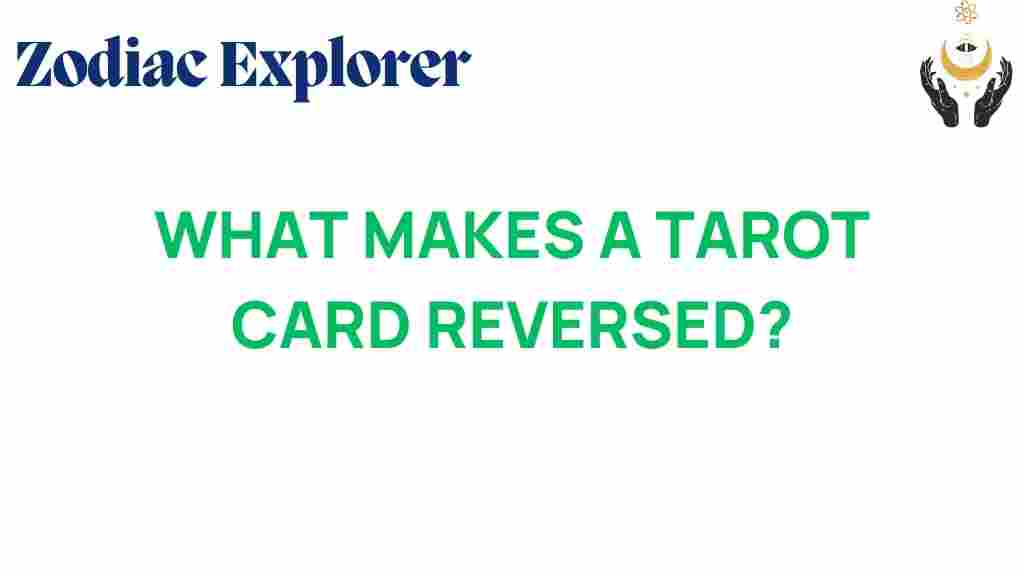Unlocking the Mysteries: What Makes a Tarot Card Reversed?
Tarot has long been a trusted tool for divination and spiritual guidance, offering insights into our lives, emotions, and potential futures. One intriguing aspect of tarot reading is the interpretation of reversed cards. Understanding what makes a tarot card reversed can greatly enhance your readings and deepen your connection to the cards. In this article, we will explore the meanings behind reversed cards, their significance in tarot readings, and how they can aid in self-discovery and intuition.
Understanding Tarot and Reversed Cards
Before delving into the intricacies of reversed cards, it’s essential to grasp the basics of tarot. A tarot deck typically consists of 78 cards divided into the Major Arcana and Minor Arcana. Each card carries its own symbolism and meaning, offering insights into various aspects of life.
When a card appears reversed in a tarot reading, it is positioned upside down. This orientation often alters its meaning, providing a different perspective or nuance. Here are some key points to consider regarding reversed cards:
- Altered Meanings: Reversed cards can signify obstacles, blockages, or internal struggles.
- Introspection: They often encourage self-reflection and a deeper understanding of oneself.
- Intuition: Reversed cards can urge you to trust your intuition and inner wisdom.
The Symbolism of Reversed Cards
The symbolism of reversed cards can be rich and varied. Here’s a breakdown of common themes associated with reversed tarot cards:
- Challenges: Reversed cards often point to challenges or issues that need addressing.
- Inner Work: They may suggest a need for personal growth and transformation.
- Delays: Reversed cards can indicate delays or setbacks in a situation.
- Reflection: These cards invite you to reflect on your choices and their consequences.
Interpreting Reversed Cards in Tarot Readings
When conducting a tarot reading, the placement of reversed cards can significantly influence the overall narrative of the spread. Here’s a step-by-step process for interpreting reversed cards:
Step 1: Identify the Card
Begin by identifying the card and its traditional upright meaning. Understanding the card’s basic symbolism is essential before interpreting its reversed position.
Step 2: Consider the Context
The context of the reading is crucial. Consider the surrounding cards and the question asked. This can give you clues about how the reversed card’s meaning may apply to the situation.
Step 3: Analyze the Reversal
Reflect on what the reversal signifies. Some common interpretations include:
- Blockages: Are there obstacles preventing progress?
- Self-Doubt: Is there an underlying lack of confidence?
- Internal Struggles: Are you facing inner conflicts related to the card’s theme?
Step 4: Connect to Your Intuition
Trust your intuition during the reading. Sometimes, the most profound meanings come from your personal insights and feelings about the cards. Allow your inner voice to guide you toward understanding the messages conveyed by the reversed cards.
Step 5: Provide Spiritual Guidance
Use the insights gained from the reversed cards to offer spiritual guidance. Whether it’s a message of hope, a call to action, or an invitation to reflect, ensure the reading resonates with the querent’s journey.
Troubleshooting Common Issues with Reversed Cards
While interpreting reversed cards can be enlightening, it can also pose challenges. Here are some troubleshooting tips to help navigate potential issues:
- Confusion with Meanings: If you’re struggling to understand a reversed card, consult tarot reference books or reputable online resources. For example, Tarot.com offers detailed card meanings.
- Overanalysis: Avoid overthinking the reversed meanings. Sometimes, a simple interpretation is the most accurate.
- Emotional Reactions: If a reversed card elicits a strong emotional response, take a moment to breathe and center yourself before continuing the reading.
- Card Combinations: Pay attention to how reversed cards interact with other cards in the spread. Their meanings can change significantly based on the context.
Examples of Common Reversed Tarot Cards
To provide a clearer understanding of reversed cards, here are a few examples of commonly encountered cards and their reversed meanings:
The Fool (Reversed)
The Fool reversed can signify recklessness or a lack of direction. It may suggest that the querent is avoiding new beginnings or is hesitant to take a leap of faith.
The Tower (Reversed)
The Tower reversed often indicates a fear of change or an avoidance of necessary upheaval. It can suggest that the querent is resisting transformation.
The Lovers (Reversed)
The Lovers reversed may point to disharmony in relationships or internal conflicts regarding love. It encourages the querent to examine their values and choices.
The Chariot (Reversed)
The Chariot reversed can symbolize a lack of control or direction in life. It suggests that the querent may be feeling overwhelmed or unable to move forward.
Deepening Your Understanding of Tarot
As you explore reversed cards in tarot, consider expanding your knowledge through various resources. Books, online courses, and workshops can help deepen your understanding of tarot meanings and card symbolism.
One excellent resource for further learning is Biddy Tarot, which offers a wealth of information on tarot readings, card interpretations, and intuitive practices. Engaging with the tarot community can also provide valuable insights and experiences that enhance your practice.
Conclusion
Reversed cards in tarot hold unique meanings that can provide profound insights into your life and journey. By understanding what makes a tarot card reversed, you can unlock deeper layers of interpretation and intuition. Embrace the challenges and lessons that reversed cards present, and use them as a tool for self-discovery and spiritual guidance. With practice and reflection, your tarot readings will become a powerful source of insight and growth.
Remember, tarot is a personal journey. Each reading is an opportunity to connect with your inner self and explore the mysteries of life. Embrace the reversed cards as a vital part of your tarot practice, and let them guide you on your path of divination and understanding.
This article is in the category Myths and created by ZodiacExplorer Team
